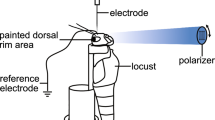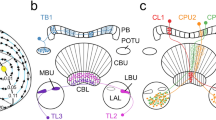Abstract
Desert locusts (Schistocerca gregaria) sense the plane of dorsally presented polarized light through specialized dorsal eye regions that are likely adapted to exploit the polarization pattern of the blue sky for spatial orientation. Receptive fields of these dorsal rim photoreceptors and polarization-sensitive interneurons are directed toward the upper sky but may extend to elevations below 30°. Behavioral data, however, suggests that S. gregaria is even able to detect polarized light from ventral directions but physiological evidence for this is still lacking. In this study we characterized neurons in the locust brain showing polarization sensitivity at low elevations down to the horizon. In most neurons polarization sensitivity was absent or weak when stimulating from the zenith. All neurons, including projection and commissural neurons of the optic lobe and local interneurons of the central brain, are novel cell types, distinct from polarization-sensitive neurons studied so far. Painting dorsal rim areas in both eyes black to block visual input had no effect on the polarization sensitivity of these neurons, suggesting that they receive polarized light input from the main eye. A possible role of these neurons in flight stabilization or the perception of polarized light reflected from bodies of water or vegetation is discussed.










Similar content being viewed by others
Abbreviations
- Φ:
-
E-vector angle
- AMMC:
-
Antennal mechanosensory and motor center
- DRA:
-
Dorsal rim area
- E-vector:
-
Electric field vector
- IL neurons:
-
Interlobula neurons
- IM neurons:
-
Intermedulla neurons
- LP neurons:
-
Lobula projection neurons
- MEHF neurons:
-
Medulla equatorial horizontal fascicle neurons
- MLP neurons:
-
Medulla-lobula projection neurons
- NaPi:
-
Sodium phosphate buffer
- NGS:
-
Normal goat serum
- PBS:
-
Phosphate-buffered saline
- PBT:
-
Phosphate-buffered saline with Triton X-100
- POL:
-
Polarization
- PS:
-
POL sensitivity
References
Batschelet E (1981) Circular statistics in biology. Academic Press, New York
Bech M, Homberg U, Pfeiffer K (2014) Receptive fields of locust brain neurons are matched to polarization patterns of the sky. Curr Biol 24:2124–2129
Beetz MJ, el Jundi B, Heinze S, Homberg U (2015) Topographic organization and possible function of the posterior optic tubercles in the brain of the desert locust Schistocerca gregaria. J Comp Neurol 523:1589–1607
Beetz MJ, Hechavarría JC, Kössl M (2016) Temporal tuning in the bat auditory cortex is sharper when studied with natural echolocation sequences. Sci Rep 6:29102. doi:10.1038/srep29102
Bockhorst T, Homberg U (2015) Amplitude and dynamics of polarization-plane signaling in the central complex of the locust brain. J Neurophysiol 113:3291–3311
Boda P, Horváth G, Kriska G, Blahó M, Csabai Z (2014) Phototaxis and polarotaxis hand in hand: night dispersal flight of aquatic insects distracted synergistically by light intensity and reflection polarization. Naturwissenschaften 101:385–395
Camhi JM (1971) Flight orientation in locusts. Sci Am 225(2):74–81
Chung S, Li XR, Nelson SB (2002) Short-term depression at thalamocortical synapses contributes to rapid adaptation of cortical sensory responses in vivo. Neuron 34:437–446
el Jundi B, Pfeiffer K, Homberg U (2011) A distinct layer of the medulla integrates sky compass signals in the brain of an insect. PLoS ONE 6:e27855
Elphick MR, Williams L, O’Shea M (1996) New features of the locust optic lobe: evidence of a role for nitric oxide in insect vision. J Exp Biol 199:2395–2407
Enserink M (2004) Entomology. Can the war on locusts be won? Science 306:1880–1882
Gewecke M, Hou T (1992) Structure and function of visual interneurons in the locust brain. In: Singh RN (ed) Nervous systems, principles of design and function. Wiley, New Delhi, pp 255–270
Gewecke M, Hou T (1993) Visual brain neurons in Locusta migratoria. In: Gribakin FG, Popov AV, Renninger G (eds) Sensory systems of arthropods. Birkhäuser, Basel, pp 119–144
Griss C, Rowell CHF (1986) Three descending interneurons reporting deviation from course in the locust. 1. Anatomy. J Comp Physiol A 158:765–774
Heinze S, Homberg U (2007) Maplike representation of celestial E-vector orientations in the brain of an insect. Science 315:995–997
Heinze S, Gotthardt S, Homberg U (2009) Transformation of polarized light information in the central complex of the locust. J Neurosci 29:11783–11793
Helfrich-Förster C, Stengl M, Homberg U (1998) Organization of the circadian system in insects. Chronobiol Int 15:567–594
Hensler K (1989) Corrective flight steering in locusts: convergence of extero- and proprioceptive inputs in descending deviation detectors. In: Singh RN, Strausfeld NJ (eds) Neurobiology of sensory systems. Plenum Press, London, pp 531–554
Henze MJ, Dannenhauer K, Kohler M, Labhart T, Gesemann M (2012) Opsin evolution and expression in arthropod compound eyes and ocelli: insights from the cricket Gryllus bimaculatus. BMC Evol Biol 12:163. doi:10.1186/1471-2148-12-163
Homberg U (2004) In search of the sky compass in the insect brain. Naturwissenschaften 91:199–208
Homberg U (2015) Sky compass orientation in desert locusts—evidence from field and laboratory studies. Front Behav Neurosci 9:346
Homberg U, Paech A (2002) Ultrastructure and orientation of ommatidia in the dorsal rim area of the locust compound eye. Arthropod Struct Dev 30:271–280
Homberg U, Hofer S, Pfeiffer K, Gebhardt S (2003) Organization and neural connections of the anterior optic tubercle in the brain of the locust, Schistocerca gregaria. J Comp Neurol 462:415–430
Horváth G (1995) Reflection polarization patterns at flat water surfaces and their relevance for insect polarization vision. J Theor Biol 175:27–37
Horváth G, Majer J, Horváth L, Szivak I, Kriska G (2008) Ventral polarization vision in tabanids: horseflies and deerflies (Diptera: tabanidae) are attracted to horizontally polarized light. Naturwissenschaften 95:1093–1100
Hu XB, England JH, Lani AC, Tung JJ, Ward NJ, Adams SM, Barber KA, Whaley MA, O’Tousa JE (2009) Patterned rhodopsin expression in R7 photoreceptors of mosquito retina: implications for species-specific behavior. J Comp Neurol 516:334–342
Kelber A (1999) Why’ false’ colours are seen by butterflies. Nature 402:251
Kelber A, Thunell C, Arikawa K (2001) Polarisation-dependent colour vision in Papilio butterflies. J Exp Biol 204:2469–2480
Kelly KM, Mote MI (1990a) Avoidance of monochromatic light by the cockroach Periplaneta americana. J Insect Physiol 36:287–291
Kelly KM, Mote MI (1990b) Electrophysiology and anatomy of medulla interneurons in the optic lobe of the cockroach, Periplaneta americana. J Comp Physiol A 167:745–756
Kennedy JS (1945) Observations on the mass migration of desert locust hoppers. Trans Roy Ent Soc London 95:247–262
Kennedy JS (1951) The migration of the desert locust (Schistocerca gregaria Forsk.). I. The behaviour of swarms. II. A theory of long-range migrations. Philos Trans R Soc Lond B Biol Sci 235:163–290
Labhart T (1999) How polarization-sensitive interneurones of crickets see the polarization pattern of the sky: a field study with an optoelectronic model neurone. J Exp Biol 202:757–770
Labhart T, Meyer EP (1999) Detectors for polarized skylight in insects: a survey of ommatidial specializations in the dorsal rim area of the compound eye. Microsc Res Tech 47:368–379
Latchininsky AV (2010) Locusts. In: Breed AD, Moore J (eds) Encyclopedia of animal behavior, vol 2. Academic Press, Oxford, pp 288–295
Laughlin SB (1976) Sensitivities of dragonfly photoreceptors and voltage gain of transduction. J Comp Physiol 111:221–247
Laughlin S, McGinness S (1978) Structures of dorsal and ventral regions of a dragonfly retina. Cell Tissue Res 188:427–447
Leggett LMW (1976) Polarized light-sensitive interneurones in a swimming crab. Nature 262:709–711
Lomer CJ, Bateman RP, Johnson DL, Langewald J, Thomas M (2001) Biological control of locusts and grasshoppers. Annu Rev Entomol 46:667–702
Mappes M, Homberg U (2004) Behavioral analysis of polarization vision in tethered flying locusts. J Comp Physiol A 190:61–68
Nelson SB (1991) Temporal interactions in the cat visual system. 1. Orientation-selective suppression in the visual cortex. J Neurosci 11:344–356
Osorio D (1986a) Directionally selective cells in the locust medulla. J Comp Physiol A 159:841–847
Osorio D (1986b) Ultraviolet sensitivity and spectral opponency in the locust. J Exp Biol 122:193–208
Pfeiffer K, Kinoshita M, Homberg U (2005) Polarization-sensitive and light-sensitive neurons in two parallel pathways passing through the anterior optic tubercle in the locust brain. J Neurophysiol 94:3903–3915
Reichert H (1993) Sensory inputs and flight orientation in locusts. Comp Biochem Physiol A 104:647–657
Reischig T, Stengl M (2003) Ectopic transplantation of the accessory medulla restores circadian locomotor rhythms in arrhythmic cockroaches (Leucophaea maderae). J Exp Biol 206:1877–1886
Rind FC (1987) Non-directional, movement sensitive neurones of the locust optic lobe. J Comp Physiol A 161:477–494
Rind FC (1990) A directionally selective motion-detecting neurone in the brain of the locust: physiological and morphological characterization. J Exp Biol 149:1–19
Rossel S, Wehner R, Lindauer M (1978) E-vector orientation in bees. J Comp Physiol 125:1–12
Rowell CHF (1988) Mechanisms of flight steering in locusts. Experientia 44:389–395
Schmeling F, Wakakuwa M, Tegtmeier J, Kinoshita M, Bockhorst T, Arikawa K, Homberg U (2014) Opsin expression, physiological characterization and identification of photoreceptor cells in the dorsal rim area and main retina of the desert locust, Schistocerca gregaria. J Exp Biol 217:3557–3568
Schmeling F, Tegtmeier J, Kinoshita M, Homberg U (2015) Photoreceptor projections and receptive fields in the dorsal rim area and main retina of the locust eye. J Comp Physiol A 201:427–440
Schneider L, Langer H (1969) Die Struktur des Rhabdoms im “Doppelauge” des Wasserläufers Gerris lacustris. Z Zellforsch 99:538–559
Schwind R (1991) Polarization vision in water insects and insects living on a moist substrate. J Comp Physiol A 169:531–540
Schwind R, Horváth G (1993) Reflection-polarization pattern at water surfaces and correction of a common representation of the polarization pattern of the sky. Naturwissenschaften 80:82–83
Sharp PE, Blair HT, Cho JW (2001) The anatomical and computational basis of the rat head-direction cell signal. Trends Neurosci 24:289–294
Shashar N, Sabbah S, Aharoni N (2005) Migrating locusts can detect polarized reflections to avoid flying over the sea. Biol Lett 1:472–475
Stern M, Gewecke M (1993) Spatial sensitivity profiles of motion sensitive neurons in the locust brain. In: Wiese K, Gribakin FG, Popov AV, Renninger G (eds) Sensory systems of arthropods. Birkhäuser, Basel, pp 184–195
Strausfeld NJ (1976) Atlas of an insect brain. Springer, Berlin
Strutt JW (1871) On the light from the sky, its polarization and colour. Philos Mag 41:107–120
Taube JS (2007) The head direction signal: origins and sensory-motor integration. Annu Rev Neurosci 30:181–207
Träger U, Homberg U (2011) Polarization-sensitive descending neurons in the locust: connecting the brain to thoracic ganglia. J Neurosci 31:2238–2247
Vitzthum H, Müller M, Homberg U (2002) Neurons of the central complex of the locust Schistocerca gregaria are sensitive to polarized light. J Neurosci 22:1114–1125
Wehner R (2001) Polarization vision - a uniform sensory capacity? J Exp Biol 204:2589–2596
Wehr M, Zador AM (2005) Synaptic mechanisms of forward suppression in rat auditory cortex. Neuron 47:437–445
Wernet MF, Velez MM, Clark DA, Baumann-Klausener F, Brown JR, Klovstad M, Labhart T, Clandinin TR (2012) Genetic dissection reveals two separate retinal substrates for polarization vision in Drosophila. Curr Biol 22:12–20
Wildermuth H (1998) Dragonflies recognize the water of rendezvous and oviposition sites by horizontally polarized light: a behavioural field test. Naturwissenschaften 85:297–302
Zar J (1999) Biostatistical analysis, 4th edn. Prentice Hall, Upper Saddle River
Acknowledgments
We are grateful to Drs. Erich Buchner (University of Würzburg) and Hans Agricola (University of Jena) for the donation of antisera, and to Martina Kern for maintaining the locust cultures. This work was supported by grants from Deutsche Forschungsgemeinschaft (HO 950/16-3 and HO 950/23-1) to UH.
Author information
Authors and Affiliations
Corresponding author
Ethics declarations
Author contributions
MJB performed experiments. KP wrote scripts for recordings and analysis. MJB and KP analysed data. MJB wrote manuscript. MJB and UH conceived and directed the study. All authors discussed the results and commented on the manuscript.
Author information
The authors declare no competing financial interests. Readers are welcome to comment on the online version of the paper. Correspondence and requests for materials should be addressed to U.H. (homberg@biologie.uni-marburg.de).
Rights and permissions
About this article
Cite this article
Jerome Beetz, M., Pfeiffer, K. & Homberg, U. Neurons in the brain of the desert locust Schistocerca gregaria sensitive to polarized light at low stimulus elevations. J Comp Physiol A 202, 759–781 (2016). https://doi.org/10.1007/s00359-016-1116-x
Received:
Revised:
Accepted:
Published:
Issue Date:
DOI: https://doi.org/10.1007/s00359-016-1116-x




